The Shadow of Mordor
One Ring to rule them all, One Ring to find them,
One Ring to bring them all and in darkness bind them.
Sauron settled in Mordor 1,000 years after the end of the First Age, and it remained the pivot of his evil contemplations for the whole of the Second and Third Ages of Middle-earth. In the north-western corner of this land stood Mount Doom or Orodruin, where Sauron had forged the One Ring. Near Orodruin stood Sauron's stronghold Barad-dûr. After this time, Sauron was known as the Dark Lord of Mordor.For two and a half thousand years, Sauron ruled Mordor uninterruptedly. Having wrought the Ring, it was from there that he launched the attack upon the Elves of Eregion. He was repelled by the Men of Númenor. He fought against the Men again, almost a thousand years later; that time, he was captured by the Númenóreans and brought to their island kingdom, eventually causing its destruction. Immediately after Númenor's destruction, Sauron returned to Mordor as a spirit and resumed his rule.
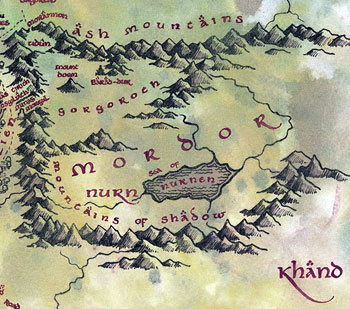
Sauron's rule was interrupted yet again when his efforts to overthrow the surviving Men and Elves failed, and they fought their way back to their foe's domain. After several years of siege, forces of the Last Alliance of Elves and Men came into Mordor. Sauron was defeated in a final battle on the slopes of Orodruin. For about a thousand years, Mordor was guarded by Gondor in order to prevent any evil forces from breaking out.
However Gondor had failed in the long run, and deprived of guard, Mordor began to fill with evil things again. Minas Ithil was conquered by the Nine Ringwraiths; other fortifications that were supposed to defend Gondor from the menace inside Mordor were turned into a means of shielding Mordor. By the time Sauron returned into Mordor after his false defeat in Dol Guldur, Mordor was protected too well to be captured by any military might that was available in Middle-earth at the end of the Third Age. In the north of Mordor during the War of the Ring were the great garrisons and forges of war, while surrounding the bitter inland Sea of Núrnen to the south lay the vast fields tended for the provision of the armies by hordes of slaves brought in from lands to the east and south.
Now, at the end of the Third Age, Sauron is ready and gathering his armies for his final strike. With the combined forces Mordor and its Vassals, there is but one task left to do. The destruction of the world of men.
The Vassals of Mordor
Harad
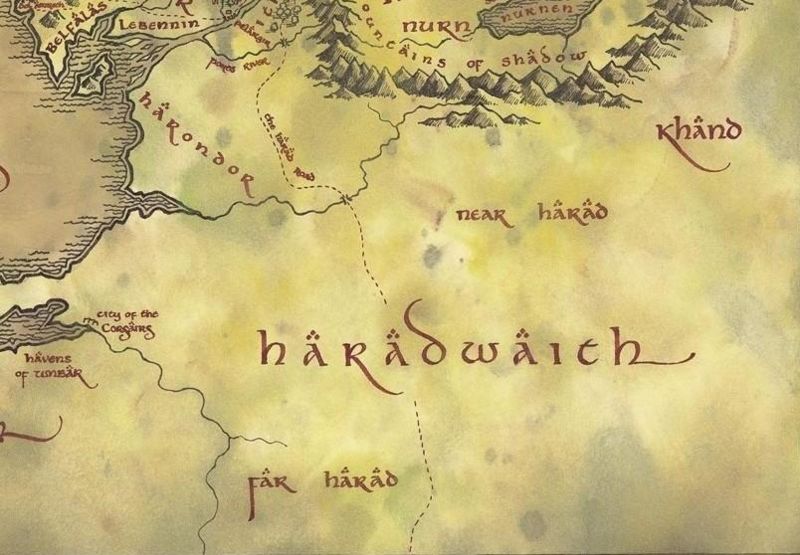
Harad was located south of Mordor. The Mountains of Shadow were on the northern border of Harad. The River Harnen flowed westward from the Mountains of Shadow to the Bay of Belfalas, forming Harad's border with South Gondor - a desert region that was contested between Gondor and Harad. The Harad Road ran from Harad northward through South Gondor and on to Ithilien.To the northeast of Harad was Khand, a land that also had ties with Sauron. It is not known how far eastward or southward Harad stretched. On the west, Harad was bounded by the Bay of Belfalas and the Sea.The northernmost part of Harad was called Near Harad and the southern part was Far Harad. On the coast there was a natural harbor with a narrow cape curving around it. The coastal region around the harbor was known as Umbar, and the harbor was called the Havens of Umbar. The seafaring raiders known as the Corsairs lived there. At the eastern end of the harbor was the City of the Corsairs.Much of Far Harad was a jungle, although there also was a desert. In the Great Forest of the South in Far Harad lived the gigantic Oliphaunts, which were used by the Haradrim as moving war towers.
During the Second Age, the Haradrim came in contact with Sauron and with the Númenóreans. The Men of Numenor explored the coasts of Middle-earth, including the coast of Harad. In the 9th century of the Second Age, the great mariner Aldarion explored the coast of Harad far to the south and was nearly shipwrecked. The Númenóreans, who had explored and colonized the Harad coastlines, initially benefited the people in the lands they explored by teaching them many things about agriculture and craftsmanship. The Númenóreans made settlements on the southern coasts, including the Havens of Umbar where they built a great fortress in 2280.After the reign of Tar-Ciryatan, Númenóreans began to set themselves up as lords in Middle-earth as they demanded tribute of goods and wealth, causing the opression of the Haradrim. Sauron did not at first dare to extend his power to the coast where the Númenóreans held power. But after the forging of the Rings of Power and the emergence of the Nazgûl, Sauron began to attack the Numenorean settlements on the coast.Ar-Pharazôn of Numenor landed at Umbar in 3261 with a great fleet and the people on the coasts fled before them. Sauron's forces refused to fight, and he allowed himself to be taken to Numenor where he corrupted the King and his followers. Under Ar-Pharazon, the Númenóreans made war on the Men of Middle-earth, and they also enslaved them and used them for human sacrifices. The Númenóreans who lived in Harad survived the destruction of Númenor in 3319. They became known as the Black Númenóreans because they remained under the influence of Sauron. Shortly before the War of the Last Alliance, two Númenórean lords, named as Herumorand Fuinur, "rose to great power amongst the Haradrim", but their ultimate fate is not recorded.
For many centuries of the Third Age, many Haradrim were still ruled by Black Númenórean Lords, or further north by the Kings ofGondor, but ultimately, the Harad fell under the influence of Mordor, for much of the Age.Near Harad later formed an alliance—or maybe even a coalition of some sort—with the Corsairs of Umbar, and was involved in a series of continual battles with Gondor over South Gondor or Harondor. Anciently its northern border was held to be the river Harnen, but by the time of the War of the Ring all the land south of the river Poros was under the influence of the Haradrim.
Umbar

The Haven of Umbar was a great haven to the far south of Gondor in Middle-earth. It was located south of the outflow of Anduin at the Bay of Belfalas in a convenient, useful natural haven. The great cape and land-locked firth formed the port. The natives called it "Umbar" and the Númenóreans who discovered it, adopted its name. Like the earlier New Haven in Enedwaith, and the later Pelargir on the Anduin, Umbar was one of the trading ports at the southern coast of Middle-earth, which became a base from which Númenórean influence spread over Middle-earth. In S.A. 2280 it was made into a great fortress as a reaction to the growing threat of Sauron and became the strongest and most important.During the dissension arising when the Shadow fell on Númenor, Umbar was the northernmost settlement of the King's Men; Sauron, after trying to break the waxing Númenórean grip by instigation, attempted to attack the Númenórean havens and forts, invaded their coastlands, but Umbar resisted It was at Umbar that Ar-Pharazôn the Golden, landed in S.A. 3261, to challenge Sauron and journeyed 7 days with banner and trumpet. Umbar remained a symbol of Númenórean pride ever after.While Sauron was in Númenór and the Shadow and dissidence became greater, Umbar was one of the fortresses and dwellings upon the coasts, inhabited by the King's Men and servants in Middle-earth to his will; these evil lords concentrated mostly to the south, far from the dominion of Gil-galad. Umbar must have been an important point of deportation for the slaves and taxes for Númenor. After the Downfall of Númenor, Umbar remained in the hands of the Númenóreans, in essence a realm-in-exile alongside Arnor and Gondor. But unlike these others, Umbar had been used by the Black Númenóreans, who were not friendly to the Elves or to their fellow Faithful Númenórean survivors. The Umbar settlers further descended into evil, and were called the Black Númenóreans. They took to pillaging and piracy along the coasts of Gondor. During the Kin-strife, the defeated rebels of Gondor fled to Umbar — by this time Umbar became the hated enemy of Gondor. By the time of the War of the Ring, the Corsairs had mixed with the Haradrim, becoming a mixed people where Númenórean blood was mostly gone.
Rhûn
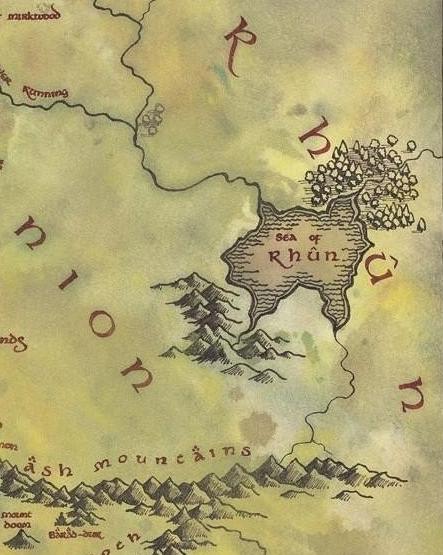
Rhûn refers to the little-known lands to the east of Middle-earth inhabited by peoples known as the "Easterlings", from whom many attacks on Gondor and its allies came during the Third Age. Rhûn was the domain of the Easterlings, Men of Darkness who were ready to follow both the Dark Lords and fought as their allies in war. These lands, too, were peopled by lost Elves, Avari and Úmanyar, and by four of the seven clans of the Dwarves who dwelt in the Orocarni.
It contains the great Sea of Rhûn, connected with three rivers, one northeast, a part of River Running, one northwest and one running south to Mordor. It also shows a small mountain range southeast of the sea and a forest northwest of it. Northwest of the Sea of Rhûn lays also the land of Dorwinion. The inland Sea of Rhûn was located in western Rhûn on the border between Rhûn and Wilderland. There were mountains on the southwest side of the Sea of Rhûn and a forest on the northeast side. Wild white Kine of Araw, or oxen, lived near the shores of the Sea of Rhûn.
During the Third Age, Rhûn was visited by three Wizards; Saruman, Rómestámo and Morinehtar, and though Saruman returned into the west, the two Blue Wizards remained. Even Gandalf had never explored there, and though Aragorn had travelled there, he never reported of his doings.Sauron himself journeyed into the eastward lands, in hiding from the White Council during the centuries of the Watchful Peace.
Rhûn was conquered by Gondor twice: under the Kings Rómendacil I and Rómendacil II, but the Númenóreans never had full control over it.
Major Strongholds and Settlements
Barad-dûr
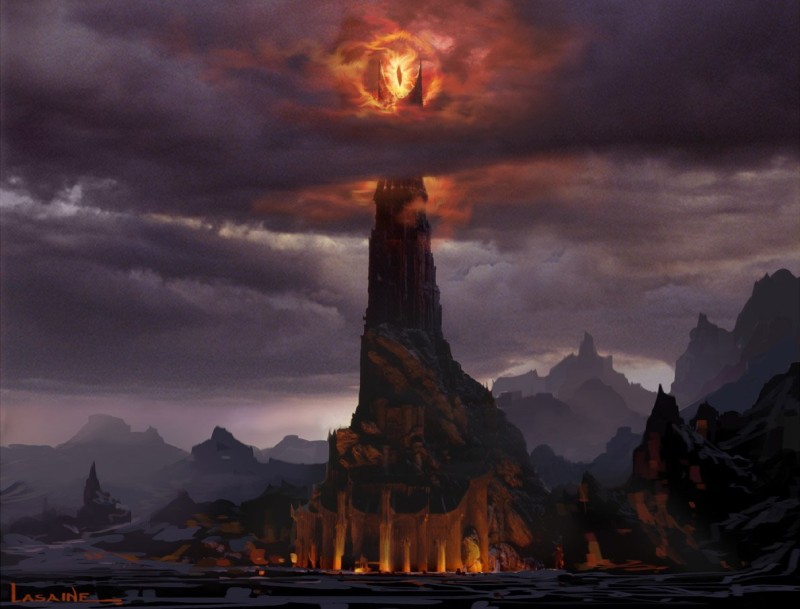
Barad-Dûr was built upon the end of a long southern spur of the Ered Lithui in the northern part of the Plateau of Gorgoroth. It stood about 30 miles east of Mount Doom and about 100 miles southeast of the Black Gate. There was both a road leading north to the Black Gate and Sauron's road to the Sammath Naur leading west to Mount Doom. Latter ran from the Dark Tower's western gate over a deep abyss, the plain and around the mountain to the dark entrance of the Chambers of Fire.Barad-Dûr was the greatest fortress ever built since the Fall of Angband. It was founded upon a mighty iron mountain throne above immeasurable pits and appeared even blacker and darker than the mantling clouds and shades in which it stood. It was immeasurably strong with its countless gargantuan towers, walls and battlements and was made of very hard and unbreakable substances. Usually it was described as made of steel, iron or adamant. It had gaping gates, great courts and dungeons with deep and terrible prisons. Its topmost tower had cruel pinnacles and an iron crown from which in immeasurable height the piercing and never sleeping eye of Sauron stared out.
Minas Morgul
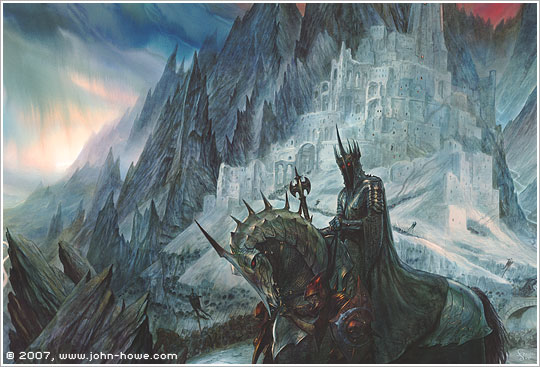
After the destruction of Númenor, Isildur and Anárion, the sons of Elendil, landed in Gondor. Isildur built Minas Ithil near the mountainous border of Mordor, while Anárion built Minas Anor. Minas Ithil housed a palantír, the Ithil-stone.When Sauron returned after escaping Númenor's destruction, he attacked the exiles of Númenor, and his forces took Minas Ithil by storm. When the Last Alliance of Elves and Men defeated Sauron in the year T.A. 3429, Minas Ithil was restored as a watchtower.
In T.A. 1980, the Nazgûl returned to Mordor .The Ringwraiths laid siege to Minas Ithil shortly after their return, in T.A. 2002, and they took the city for their master, Sauron (who was still hidden at the time).Minas Ithil was occupied by fell creatures, and it changed into a foul, evil place. As a result, it came to be called Minas Morgul, which in the tongue of Gondor means "Tower of Dark Sorcery". The Ithil-stone, was captured.
The Black Gate
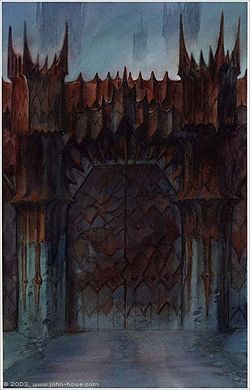 The Black Gate of Mordor was originally a gate built by Sauron, the Dark Lord of Mordor, to prevent invasion at the gap between the Ered Lithui and the Ephel Duath. It was probably built with the power of the One Ring, like the Barad-dûr. After Sauron's fall, it became a Númenorean garrison. Backed up on the other side by theIsenmouthe, and protected by the castle of Durthang to the west, it was redesigned to keep all of Mordor's evil inside, shielding the outside from it - and it from the outside. The reconstruction of Minas Ithil, Tower of the Rising Moon, as well as the construction of Cirith Ungol were also done for the same purpose.However, during the aftermath of the Kin-strife in Gondor the watchfulness of the guards in these strongholds relaxed. Thus the Ringwraiths and Orcs re-entered Mordor, eventually overrunning the garrisons and inhabiting them for themselves.
The Black Gate of Mordor was originally a gate built by Sauron, the Dark Lord of Mordor, to prevent invasion at the gap between the Ered Lithui and the Ephel Duath. It was probably built with the power of the One Ring, like the Barad-dûr. After Sauron's fall, it became a Númenorean garrison. Backed up on the other side by theIsenmouthe, and protected by the castle of Durthang to the west, it was redesigned to keep all of Mordor's evil inside, shielding the outside from it - and it from the outside. The reconstruction of Minas Ithil, Tower of the Rising Moon, as well as the construction of Cirith Ungol were also done for the same purpose.However, during the aftermath of the Kin-strife in Gondor the watchfulness of the guards in these strongholds relaxed. Thus the Ringwraiths and Orcs re-entered Mordor, eventually overrunning the garrisons and inhabiting them for themselves.
The Black Gate was set in an impregnable black stone and iron wall that stretched from the Mountains of Ash in the north to the Ephel Duath (Mountains of Shadow) in the west. The wall has been estimated to be 60 feet high and 250 feet long with each half of the great gate being 90 feet wide and set on large stone wheels. Behind the gate were gigantic circular stone ramparts, and when the gate needed to be opened, two pairs of Mountain-trolls who were tethered to gigantic beams pushed their way around their rampart's track, gradually levering open the gate and allowing for the incoming or outgoing of Mordor’s armies.
Inset within the wall were myriads of archers, spearmen, bowmen, ballistae, and hundreds of thousands of Orc troops ready to defend Mordor. The Gates themselves may have been made of the same indomitable stone that constitutes Orthanc, so hard that even the Ents could not dent it.
Dol Guldur
 Dol Guldur was established by Sauron after his return to Middle-earth somewhere after T.A. 1000, although his identity was hidden and was known as the Necromancer. Dol Guldur was originally known as Amon Lanc, and had been the capital of Oropher'sSilvan Elves, who had departed north to the Dark Mountains. After Sauron took over Amon Lanc, Thranduil son of Oropher led his people over the Forest River, where they remained. In TA 2850 Gandalf again entered Dol Guldur, found the dying Thráin, and Gandalf was entrusted with the map and key to give to Thorin, although Thráin could not tell him his own or his son's name before he died. Gandalf confirmed that Sauron was the master of Dol Guldur at that time. Gandalf returned to the White Council and urged an attack on Dol Guldur, but was overruled by Saruman, who had begun searching for the One Ring in the area by then. In T.A. 2941 Saruman finally agreed to an attack, which occurred at the same time as the Quest of Erebor. This was carefully planned by Gandalf, so that Sauron and Smaug could not assist each other, as otherwise they could easily have done. Sauron fled to Mordor, his plans now ready. Dol Guldur was reoccupied by three of the Nazgûl in 2951,one of whom was Khamûl, the second chief.
Dol Guldur was established by Sauron after his return to Middle-earth somewhere after T.A. 1000, although his identity was hidden and was known as the Necromancer. Dol Guldur was originally known as Amon Lanc, and had been the capital of Oropher'sSilvan Elves, who had departed north to the Dark Mountains. After Sauron took over Amon Lanc, Thranduil son of Oropher led his people over the Forest River, where they remained. In TA 2850 Gandalf again entered Dol Guldur, found the dying Thráin, and Gandalf was entrusted with the map and key to give to Thorin, although Thráin could not tell him his own or his son's name before he died. Gandalf confirmed that Sauron was the master of Dol Guldur at that time. Gandalf returned to the White Council and urged an attack on Dol Guldur, but was overruled by Saruman, who had begun searching for the One Ring in the area by then. In T.A. 2941 Saruman finally agreed to an attack, which occurred at the same time as the Quest of Erebor. This was carefully planned by Gandalf, so that Sauron and Smaug could not assist each other, as otherwise they could easily have done. Sauron fled to Mordor, his plans now ready. Dol Guldur was reoccupied by three of the Nazgûl in 2951,one of whom was Khamûl, the second chief.
Haven of Umbar
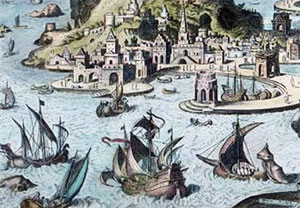
After the Downfall of Númenor, Umbar remained in the hands of the Númenóreans, in essence a realm-in-exile alongside Arnor and Gondor. But unlike these others, Umbar had been used by the Black Númenóreans, who were not friendly to the Elves or to their fellow Faithful Númenórean survivors. The Umbar settlers further descended into evil, and were called the Black Númenóreans. They took to pillaging and piracy along the coasts of Gondor. During the Kin-strife, the defeated rebels of Gondor fled to Umbar — by this time Umbar became the hated enemy of Gondor. By the time of the War of the Ring, the Corsairs had mixed with the Haradrim, becoming a mixed people where Númenórean blood was mostly gone.
Armies of Mordor
Mordor had vast armies at its disposal, all filled with a fierce hatred of the Men of the West. While the Orcs in the land may not have been the most powerful warriors, they were very fierce and could be quite overwhelming in numbers. Other units, like Trolls and allies like the Haradrim, were much more devastating.
The Easterlings were a highly cultured and more advanced race (than the Orcs) who used deadly swords and pikes to skewer their enemies into submission. They had finer quality weapons and armor, as well as better-trained soldiers. In a sense, they were more of the elite infantry of Mordor. The Haradrim used deadly bows; far superior to Orc bows, they could deal some heavy damage to enemy units before being killed. They either shot their deadly bows on the ground or on top of a Mumakil.
Orcs
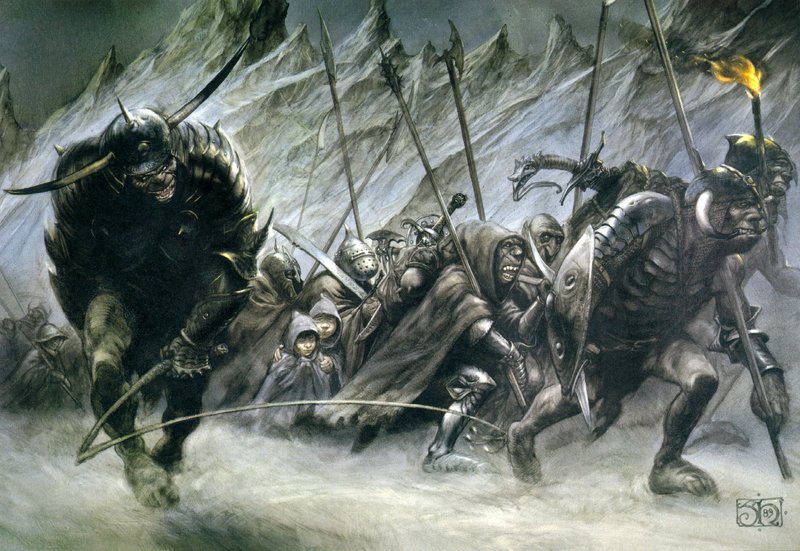
The Orcs were bred by Melkor in mockery of the Elves, sometime during the Great Darkness. It is unclear when exactly Orcs were created, but it certainly happened before the War for Sake of the Elves in his stronghold of Utumno. If the Orcs were at this time a capable fighting force against the host of Valinor is not known. But at least some of them survived this war, probably hidden in the deep vaults of Angband and multiplied, waiting for their master.When Melkor (now known as Morgoth) returned to Middle-earth he created new hordes of Orcs and invaded Beleriand, where the First Battle of Beleriand took place. Orcs fought also in Dagor-nuin-Giliath.
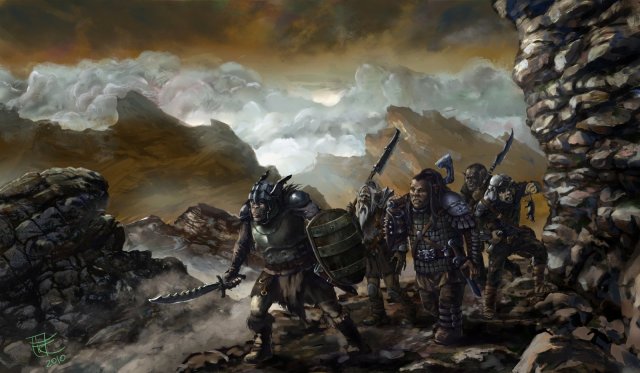
It is certain all Orcs were dependent on the Dark Lord in various ways: after their leader was defeated, the Orcs were confused and dismayed, and easily scattered by their enemies. In the millennia after Morgoth's defeat and banishment from Arda, they were without a leader they degenerated to small, quarrelsome tribes hiding in the Misty Mountains. Only when Sauron returned to power did they begin to reclaim some of their old power. The same happened after Sauron's defeat by the Last Alliance of Elves and Men: only when Sauron returned as the Necromancer of Mirkwood did the Orcs become a real danger for Middle-earth again.
Trolls
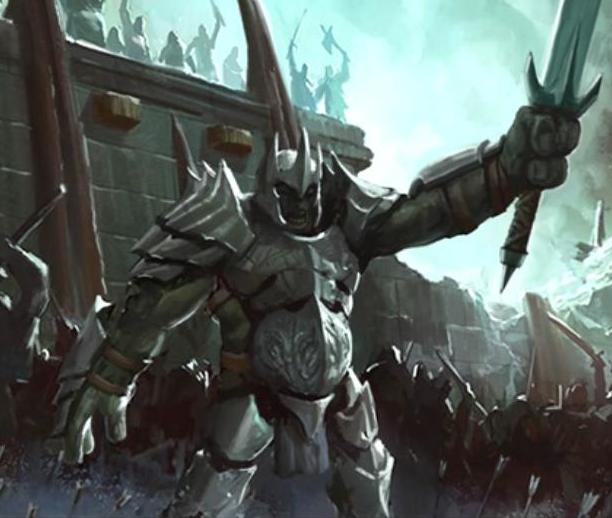 Trolls were large monsters of limited intellect. Morgoth created Trolls before the First Age. Their exact origins are unknown, though it is stated by Treebeard that Trolls were "made in mockery of" Ents, similar to the way that Orcs were bred from captured and tormented Elves.Trolls were strong and vicious, but stupid creatures, and they turned to stone in sunlight. Many Trolls died in the War of Wrath, but some survived and joined the forces of Sauron, the greatest surviving servant of Morgoth. In the Second Age and Third Age, Trolls were among Sauron's most dangerous warriors. In the Third Age, Sauron created the Olog-hai, which were more powerful than earlier breeds of Trolls. While most Trolls cannot bear exposure to sunlight without turning to stone, the Olog-hai apparently could.
Trolls were large monsters of limited intellect. Morgoth created Trolls before the First Age. Their exact origins are unknown, though it is stated by Treebeard that Trolls were "made in mockery of" Ents, similar to the way that Orcs were bred from captured and tormented Elves.Trolls were strong and vicious, but stupid creatures, and they turned to stone in sunlight. Many Trolls died in the War of Wrath, but some survived and joined the forces of Sauron, the greatest surviving servant of Morgoth. In the Second Age and Third Age, Trolls were among Sauron's most dangerous warriors. In the Third Age, Sauron created the Olog-hai, which were more powerful than earlier breeds of Trolls. While most Trolls cannot bear exposure to sunlight without turning to stone, the Olog-hai apparently could.
During the wars of Beleriand, Gothmog, the Lord of Balrogs, had a bodyguard of Trolls. While leading his men in a final stand to protect the retreat of Turgon and the continued secrecy of the Kingdom of Gondolin, the great warrior Húrin faced them, and due to Morgoth's emphatic orders to have Húrin captured alive, he managed to wipe them out. Their apparently caustic blood, however, melted his axe, allowing orcs to swarm over him and bind him, his capture ending the Nirnaeth Arnoediad, the Battle of Unnumbered Tears, where Morgoth seemingly triumphed over the united armies of Elves, Men and Dwarves.
Easterling Infantry
 Easterlings were Men who lived in the east of Middle-earth, and were enemies of the Free Peoples. These evil men all answer Saurons call and have come to fight Gondor, an old and hated enemy. These men are well equipped and not as prone to flee as the Orcs.
Easterlings were Men who lived in the east of Middle-earth, and were enemies of the Free Peoples. These evil men all answer Saurons call and have come to fight Gondor, an old and hated enemy. These men are well equipped and not as prone to flee as the Orcs.
The Easterlings had three principal weapons: their pike, the scimitar, and the composite bow.
The steel-bladed wooden halberd came in two sizes: the nine-foot halberd was used for porcupine formations and phalanx marches, while the five-foot one was used as a basic soldier's weapon. All halberds were spiked on the top (on the five-foot one it had a pike on the bottom too) and had downward-curving, serrated axe-blades, and below that halberds were backed by a curved spike; on the nine-foot one it was used to trip enemy horses while on the five-foot one it was used for piercing armor and deflecting if not disarming enemy blades. The axe blade featured a hole creating the curve. This was a truly versatile weapon that could be used both offensively and defensively.
The three-foot-bladed steel scimitar was carried by all troops as a secondary weapon. The curved blade was used in a downward, diagonal slashing attack and for thrusting. No matter which method of attack the Easterling chose to use with his scimitar, it was extremely effective in his hands.
The Composite Bow of the Easterlings was made of multiple layers of wood and was of a recurve type. They were 4 feet long at the very most, and they were carried in holsters. The arrows had hawk feathers, and the tips were forged out of steel.
Corsairs of Umbar
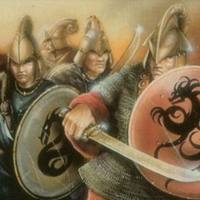 The Corsairs of Umbar were sea-raiders and pirates of the Haven of Umbar. These men were grim, brutal and fierce in their hatred of Gondor. These men often raid the coasts of Gondor and use Gondorians as slaves to man their ships.
The Corsairs of Umbar were sea-raiders and pirates of the Haven of Umbar. These men were grim, brutal and fierce in their hatred of Gondor. These men often raid the coasts of Gondor and use Gondorians as slaves to man their ships.
After the downfall of Númenor, the Umbar settlers further descended into evil, and were called the Black Númenóreans. They took to pillaging and piracy along the coasts of Gondor. During the Kin-strife, the defeated rebels of Gondor fled to Umbar. At this time Umbar became the hated enemy of Gondor. Over time these sailors drew to their number various outlaws and brigands from outlying settlements surrounding the Anduin, and they took to raiding along the southern Gondorian coast, intercepting merchant vessels and abducting women to bolster their dissident community. They were also slavers and would often seize a ship's crew along with her cargo; if any resisted, they would be thrown overboard.
By the time of the War of the Ring, the Corsairs had mixed with the Southrons, becoming a mixed people where Númenórean blood was mostly gone.
Haradrim
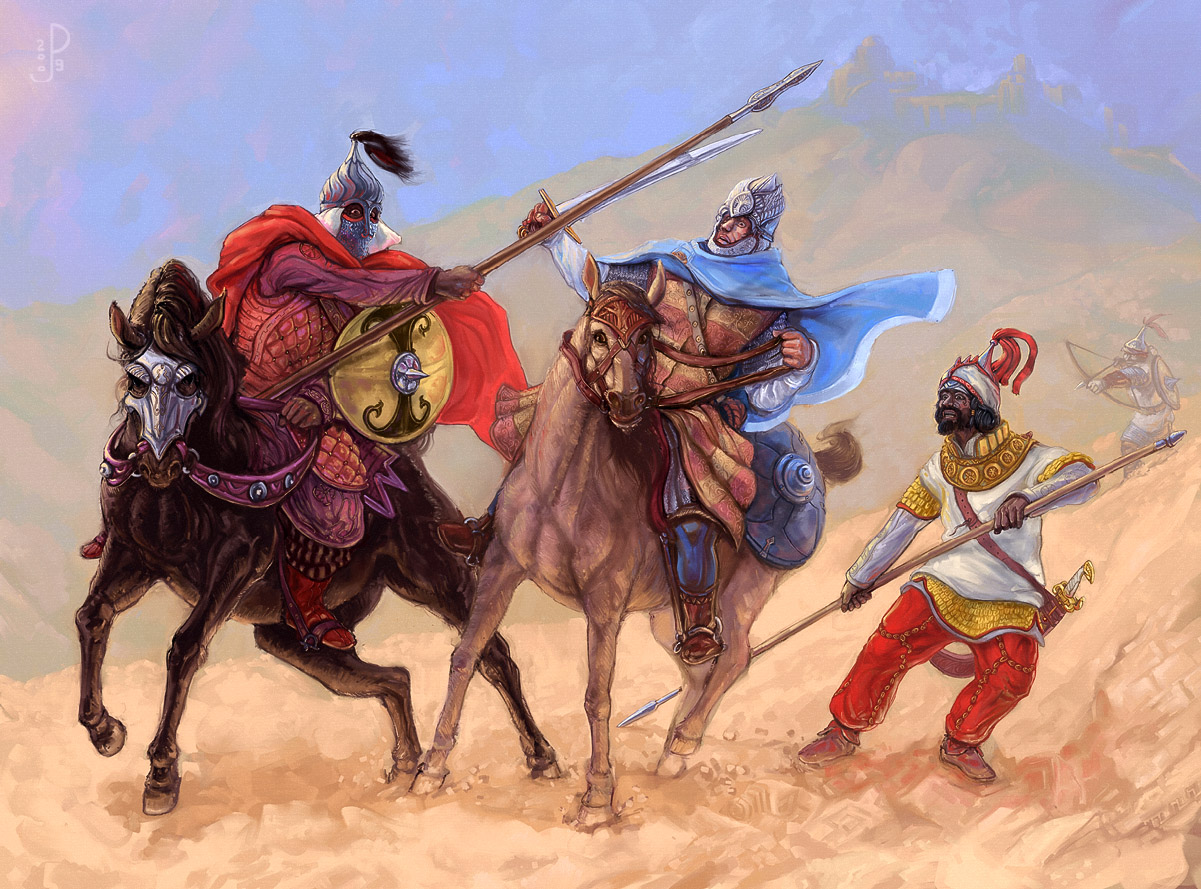 Haradrim, also called in Westron the Southrons, were a race of Men from Harad in the region of Middle-earth directly south of Gondor. Before that, in the First Age, the Atani from whom the Haradrim descended were known as Black Men.
Haradrim, also called in Westron the Southrons, were a race of Men from Harad in the region of Middle-earth directly south of Gondor. Before that, in the First Age, the Atani from whom the Haradrim descended were known as Black Men.
The Haradrim are said to be skilled archers and horsemen. In battle, they usually drove their Mûmakil into the enemy's ranks, causing terror and panic; with their foes in disarray, the Haradrim then flung spears and fired arrows down upon them from the covered canvas frame atop the mûmak. Their bows, possibly of compound design, were made out of composite materials like antlers and wood and used bamboo arrows from leather or bamboo quivers. Usually this would be enough to rout their foe, but if not the main host charged in behind the great beasts, using their spears, swords and bows with bloodthirsty zeal.
Oliphaunts
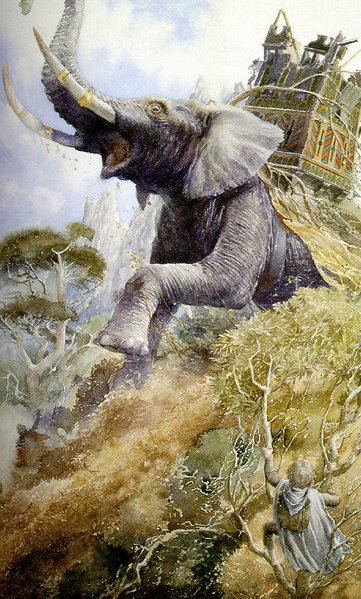 Mûmakil are huge creatures resembling oversized elephants originating from within the jungle of Far Harad and were often used in battle by the Haradrim. To most cultures, the Mûmakil were creatures of legend, as fabulous and fearsome as dragons, and to them were ascribed all kinds of strange powers. Oliphaunt was the more familiar name given to them by the Hobbits.
Mûmakil are huge creatures resembling oversized elephants originating from within the jungle of Far Harad and were often used in battle by the Haradrim. To most cultures, the Mûmakil were creatures of legend, as fabulous and fearsome as dragons, and to them were ascribed all kinds of strange powers. Oliphaunt was the more familiar name given to them by the Hobbits.
Among the tribes of Haradrim, a Mûmak would have been, literally, a huge status symbol, and there would have been great competition among the tribes to possess one; it is likely that this competition led to frequent tribal wars. The Mûmakil would have moved with the tribes as they travelled across the desert, which would have been quite often, since something as big as a Mûmak would soon have exhausted the available forage. A dead Mûmak was almost as valuable as a living one, as it would have provided the tribe with a mountain of resources: tusks, bone, hide dyes, sinew and meat that could be salted, providing the tribe with food for months.
Navy
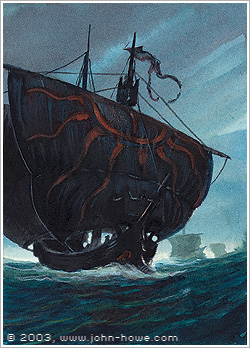 The only naval forces under Saurons command is the Black Fleet of the Corsairs from Umbar. These black ships now rally in the havens of Umbar and prepare for Saurons orders. With Gondors naval forces considerably weakened, the Corsairs of Umbar is the dominant sea power in the bay of Belfalas. The ships are thrust forward, not only bu sails, but only by slaves, captured in raids on the shores of Gondor or distant kingdoms.
The only naval forces under Saurons command is the Black Fleet of the Corsairs from Umbar. These black ships now rally in the havens of Umbar and prepare for Saurons orders. With Gondors naval forces considerably weakened, the Corsairs of Umbar is the dominant sea power in the bay of Belfalas. The ships are thrust forward, not only bu sails, but only by slaves, captured in raids on the shores of Gondor or distant kingdoms.
The warships of the Black Fleet consist primarily of Black Ships. These vessels are heavily armored and equipped with a large force of Corsairs. Their primary purpose is to ram enemy ships in order to sink it or allow the Corsairs to board enemy vessels. Other times the Black Ships stay at range and instead use fire arrows to burn down enemies.
One other noticeable class of ship is the Drommund. A very small and very fast vessel used to patrol or charge into battle, softening up the enemy formation for the bigger Black Ships. They use much of the same tactics as the Black Ships.
Armies of Mordor
Great Host of Morannon
60,000 Orcs.
Host of Minas Morgul
100,000 Orcs.
Host of Cair Andros
8,000 Orcs.
Host of Dol Guldur
30,000 Orcs.
Haradrim Legions
Legion of the Serpent
18,000 Haradrim.
Legion of the Scorpion
5,000 Haradrim.
Legion of the Eagle
7,000 Haradrim.
Easterling Legions
Dragon Legion
30,000 Easterlings.
Sun Legion
4,000 Easterlings.
Moon Legion
10,000 Easterlings.
Variag Hordes
Great Khand Horde
5,000 Variags.
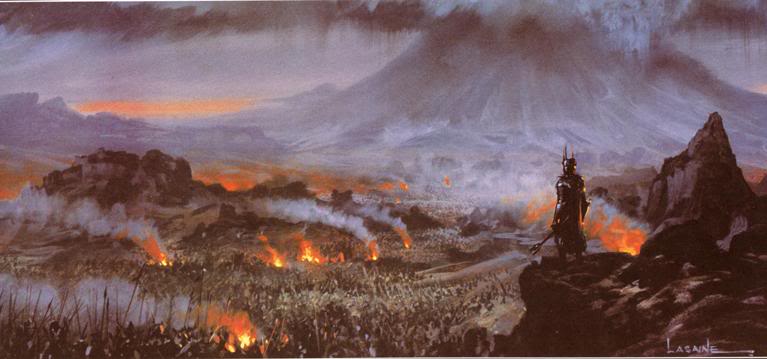

I know some of the unit descriptions are a bit lacking, but not many descriptions around and my imagination only goes so far xD
That's what happens when you insist on Lore :P
exactly :D
Lore is not the problem here. Its just my opinion that everything that was to say about the units had already been said in those few line.
What I was talking about was that the descriptions weren't very detailed and elaborate, which is a result of me being lazy, tired and what I mentioned above :P
I find your excuse terrible, you say you did a bad job and filled in a few words yet what I see is a beautiful word wall that could also double as an encyclopaedia.
I was refering to half the specifed units/type of troops. Specificly Easterlings, Corsairs and Haradrim Cavalry. Their descriptions are rather poor compared to the rest.
What did you think I was talking about? xD
About robotic dinosaurs?
*Not sure if being a **** or having bad humor*
I apologize, I made a joke whilst I requested you never joke to me since it always appears to be an insult and thus I provoked you into a response.
Regardless, I see no faults in this article so cut yourself some slack and pass it on to me, I love slack.
Well, its hard to tell when you are joking :P
But I knew it was a joke. Just responded with a joke of my own ;D
Thanks for this Cronus. Appreciate it.
waz up! i am here now the lord of tha orcs!! i only respect the forces from the realm of darknesss. fighting is my way of life!! let us join and defeat those who we hate.ready for war